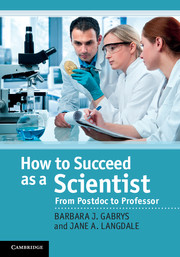Book contents
- Frontmatter
- Contents
- Preface
- Acknowledgements
- Part I Becoming an independent researcher
- Part II Thriving in your new job
- 10 Handling new roles
- 11 Learning from other people
- 12 Managing people
- 13 Building a research group I
- 14 Building a research group II
- 15 Interacting with others
- 16 Designing a taught course
- 17 Giving a good lecture
- 18 Beyond lecturing
- 19 Mentoring
- Part III Managing your career
- Index
16 - Designing a taught course
from Part II - Thriving in your new job
Published online by Cambridge University Press: 05 November 2011
- Frontmatter
- Contents
- Preface
- Acknowledgements
- Part I Becoming an independent researcher
- Part II Thriving in your new job
- 10 Handling new roles
- 11 Learning from other people
- 12 Managing people
- 13 Building a research group I
- 14 Building a research group II
- 15 Interacting with others
- 16 Designing a taught course
- 17 Giving a good lecture
- 18 Beyond lecturing
- 19 Mentoring
- Part III Managing your career
- Index
Summary
Good teaching practice takes years to mature, and its many elements cannot all be covered here – new lecturers should always attend the relevant introductory courses at their university. In this chapter we cover a few overriding principles of course design – getting the level right, deciding on the number of lectures to be delivered and the choice of different media. Educational theory as put forward by Ramsden is illustrated with examples.
The theory
Not everybody is both a gifted researcher and a good teacher; however, anyone can improve their teaching skills. Teaching presents complexity in its own right – it takes time and effort even to do it badly. Whereas bad teaching can put students off a subject for life, good teaching can help students improve their understanding of a subject and enable them to apply abstract principles to real problems. So, it helps to understand how students learn. In the last four decades, a lot of educational research has been carried out in this area (Ramsden, 2003). A good course should enable students to increase their knowledge of a subject to the extent that it ultimately changes their understanding of the world around them. Acceptance of this definition requires both a method to test this ‘understanding’ and a quantitative measure of what ‘understanding’ means in the context of a given course.
A summary of how students learn is shown in Box 16.1.
- Type
- Chapter
- Information
- How to Succeed as a ScientistFrom Postdoc to Professor, pp. 145 - 154Publisher: Cambridge University PressPrint publication year: 2011



